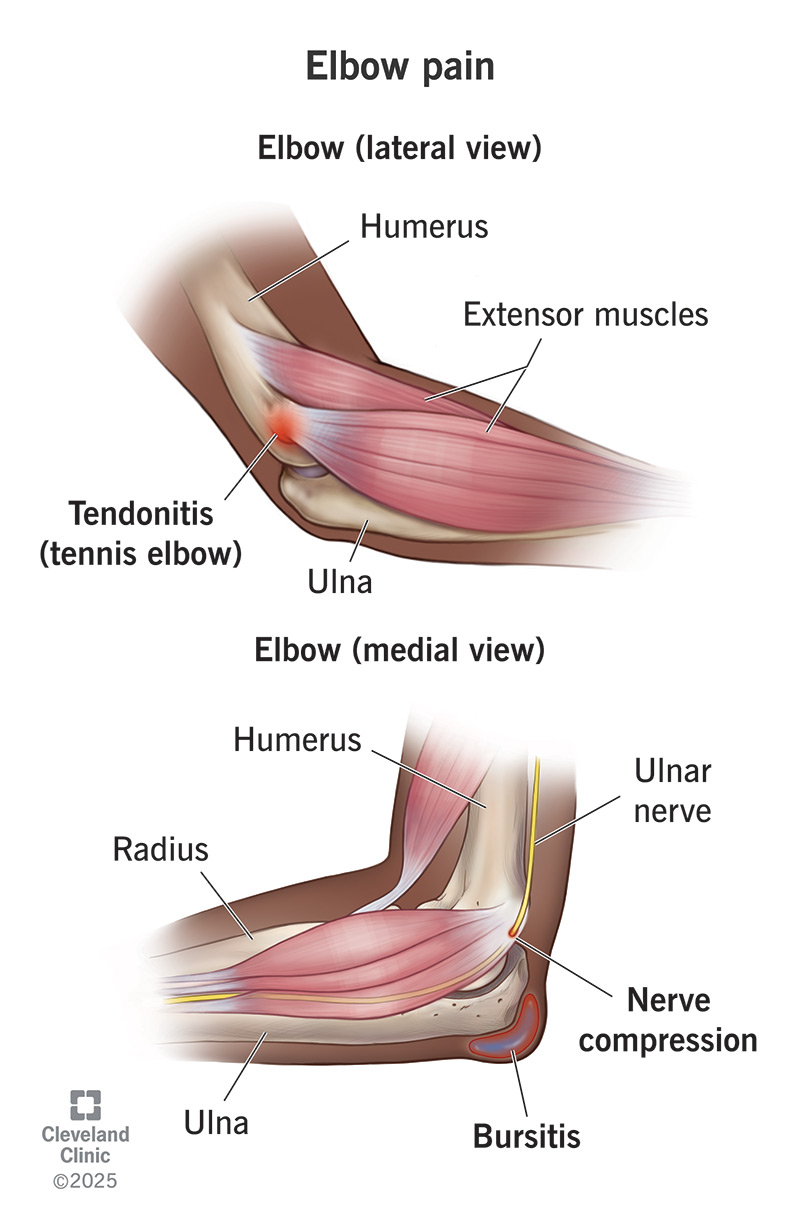If you develop sudden, unexplained pain in your elbow, it might be an overuse injury. Pain on the inside or outside when bending or straightening your arm may be related to a tendon or nerve. Repetitive strain injuries are common causes of elbow pain, and they often improve with rest. But some elbow pain needs professional treatment.
Advertisement
Cleveland Clinic is a non-profit academic medical center. Advertising on our site helps support our mission. We do not endorse non-Cleveland Clinic products or services. Policy

Elbow pain is any kind of musculoskeletal pain in or around your elbow joint. It could be related to bones, muscles, tendons, ligaments or other tissues. It could also be from an elbow injury or disease. To help figure out why your elbow hurts, your healthcare provider will ask you detailed questions about your pain, like:
Advertisement
Cleveland Clinic is a non-profit academic medical center. Advertising on our site helps support our mission. We do not endorse non-Cleveland Clinic products or services. Policy
Most causes of elbow pain aren’t serious and can heal with home care. But it’s important to understand your part in helping it heal. Some injuries and conditions will continue to worsen without appropriate care. If it’s been a week and your elbow still hurts, reach out to a healthcare provider.
Repetitive strain injuries are the most common causes of pain and tenderness in your elbow joint. These are mild injuries that happen when you use your elbow too much — for example, by repeating certain movements. They usually affect the soft tissues in your elbow joint, like tendons, bursae and nerves.
Examples include:
Advertisement
Other common causes include:
Less common causes include:
Your treatment will depend on your diagnosis. Some conditions might need surgery to improve. Others might need specific medications. Children who have a pulled elbow usually just need a quick, hands-on adjustment, called a closed reduction. But they need an experienced healthcare provider to do it.
If you have a repetitive strain injury, it might just need more time to heal than you’d expect. Tendons and ligaments heal very slowly. Your healthcare provider might suggest orthoses, like taping or bracing your elbow, to help hold your tissues in place while they heal. Other treatments might include:
Children with elbow pain should go directly to a healthcare provider for diagnosis. They’re more likely to have injuries that need hands-on treatment. But if you’re an adult, you haven’t had a memorable elbow injury and the pain in your elbow is relatively mild, you can start by treating it at home. Start with:
If your painful elbow doesn’t improve with home care, it’s time to see a healthcare provider. Your healthcare provider will get to the bottom of what’s causing your persistent elbow pain. With the right diagnosis, they can suggest treatments and a timeline that are more specific to your recovery.
Ignoring the pain in your elbow won’t help it. Any condition that causes persistent pain can do lasting damage. Injuries may heal incorrectly or fail to heal completely. Some repetitive strain injuries can even start to change your tissues. For example, chronic tendonitis that doesn’t heal can turn into tendinosis.
Advertisement
If you use your elbow often for work or recreation, take steps to reduce your risk of repetitive strain injuries. Make sure to warm up and cool down properly before activity and give your elbow time to recover afterward. If you have young children, don’t pull them or swing them around by the arms.
Seek care for elbow pain if:
Elbow pain is common in athletes who swing rackets, bats and clubs. But you can also get it from everyday activities, like digging in the garden or using a screwdriver. In most cases, it’ll feel better with a little rest and ice. But if it doesn’t, check in with a healthcare provider. It might need more specific care.
Advertisement
We diagnose and treat conditions that cause wrist pain and elbow pain. Learn how Cleveland Clinic experts use minimally invasive treatments to relieve your discomfort.

Last reviewed on 07/02/2025.
Learn more about the Health Library and our editorial process.